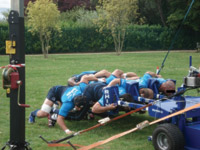
Posted to News on 28th Apr 2014, 00:00
Measuring biomechanical stresses in machine and live scrummaging
In Rugby Union, the scrum is a fundamental phase of the game that aims to restart play quickly, safely and fairly after a minor infringement or stoppage. It involves eight players from each team locking heads and shoulders, then pushing against each other to gain ground and possession of the ball. Between 6-8% of rugby injuries are sustained in scrums - however, this figure is skewed with the minor injuries inherent to the sport. Of all the catastrophic spinal injuries that occur in rugby, which often have life changing consequences, 40% are attributed to the scrum.

>The International Rugby Board (IRB) identified the need for a thorough understanding of the risk factors and physical demands of scrumming, with a focus on injury prevention and improved athletic performance. The IRB selected the Rugby Science Group at Bath University to investigate scrum mechanics and determine the causes of the injuries suffered throughout the sport. The IRB agreed to fund the research, which was conducted through two phases. Phase 1 focused on gathering data from real rugby teams scrumming against scrum machines during live training sessions, while Phase 2 involved data collection during team versus team scrummaging.
>The main system comprised a scrum machine fitted with a National Instruments cRIO-9024 controller. Scrum machines feature weighty padded frames, often mounted on wheels, which act as a safe environment to practice scrummaging techniques and build strength. The robust and hot-swappable CompactRIO modules provided the instrumentation for making measurements; the cRIO-9024 acted as an intelligent data logger.
>The scrum machine was fitted with strain gauges and accelerometers to measure forces at play. These measurements are synchronised with video captured from multiple cameras to analyse the player's technique side-by-side with the force data. In addition, a loudspeaker was mounted on-board the scrum machine so the CompactRIO system could mimic the referee by playing sound files containing shouts of crouch, touch, pause, and engage to start the scrum.
>The measurement system integrated three subsystems: a sensor (F-Scan from Tekscan) that measured pressure exerted between front-row players; inertial measurement units (MTw from Xsens Technology) that measured the accelerations experienced on the trunk and forehead anatomical segments of each front-row player; and four video cameras (two side cameras and one top camera at 50Hz, and one top camera at 200Hz) to capture player movement. A real-time cRIO-9024 controller synchronised the measuring devices, and was tightly integrated with specifically designed NI LabVIEW software.
>A prerecorded audio sequence was used to simulate two different referees' calls as a timeline for the synchronisation. The recording played on a loudspeaker to ensure consistency for all teams during experimental trials. The CompactRIO modules sent triggers to the measurement devices at appropriate times within the audio sequence to ensure collection of the relevant data. Lastly, the CompactRIO triggered LED arrays visible in each camera view at the instant of the engage or set referee commands for subsequent time synchronisation of video data and force data to within 1 ms.
>
Revolutionary results
The results from Phase 1 and Phase 2 testing revolutionised the data available and have provided the rugby community with objective biomechanical data regarding the physical stresses acting on rugby forward players, both during machine scrummaging and live scrummaging. The data gathered during Phase 1 of testing with the CompactRIO system found the magnitude peak compression forces created during scrums were twice what was recorded in the past (16.5kN versus 8.0kN for international players). The Rugby Science Group at University of Bath conducted tests using the latest in scrum machine technology in real training sessions on real rugby pitches. The NI CompactRIO accurately controlled both signal triggering and force data logging for a consistent comparison of synchronised force and kinematic data between different engagement techniques and playing levels.>The combination of LabVIEW Real-Time and CompactRIO proved ideal for this application because it offered deterministic triggering control across multiple devices simulating both training and real match conditions. The consistent data collection and full analysis of force, acceleration, and movement patterns formed a quantitative basis for any potential coaching or law amendments in the international rugby championship. Another vital approach in improving safety across the sport was broadening the pool of available data. The research team addressed this by measuring the physical stresses and movements relative to rugby players from both genders and six different skill levels-from school teams to international squads.
>Further, the cRIO-powered scrum machine enabled the University of Bath to establish an improved scrum engagement sequence (Crouch > Bind > Set). The revised scrum sequence was initially trialled in live, contested scrummaging, where the NI cRIO was used to synchronise data collection from cameras and player mounted pressure sensors and accelerometers. The resulting data showed that the new engagement sequence reduces initial scrum forces by 25%, making scrummaging safer, and less prone to collapses and time-consuming restarts.
>The Bath University researchers recommended the refined engagement sequence to the International Rugby Board, who successfully trialled the new scrums rules during the 2013 Autumn Internationals. The new engagement sequence will now be rolled out across all National and International rugby competitions, including the Rugby World Cup and European Six Nations Championship.









